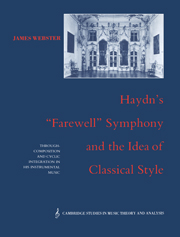 Haydn's 'Farewell' Symphony and the Idea of Classical Style
Haydn's 'Farewell' Symphony and the Idea of Classical Style Published online by Cambridge University Press: 28 January 2010
In this chapter, we turn to the central topic of Haydn's integration of multimovement instrumental cycles. But we must begin with a few caveats. Only a small minority of his works are overtly through-composed, in the manner of the Farewell Symphony. More common is to find tangible links between only two movements, or within only one musical domain (motives, tonality, gesture). And one must avoid the false assumptions that Haydn's most strongly integrated works are better than the others, or that he and his contemporaries necessarily intended or desired such integration in terms that would be intelligible today. (For our results must be intelligible today. Any viable historical study entails a synthesis of ideas from the period under investigation with others from the historian's own time.) Nevertheless, Haydn's truly cyclic works are so remarkable, and his techniques of relating the individual movements so important for his style in general, that a systematic survey is needed – especially since none has ever been attempted.
To what extent is a Haydn symphony more than a succession of separate and independent movements, related only by pleasing contrasts and continuities within the conventional generic patterns of the time? Why, in a given location in a given work, is only this movement the “right” one? If the Farewell Symphony is as strongly throughcomposed as I have suggested, why does its first Adagio resemble the slow movement of No. 42 in key, meter, and opening melodic and rhythmic motives; why could they not be exchanged?
To save this book to your Kindle, first ensure [email protected] is added to your Approved Personal Document E-mail List under your Personal Document Settings on the Manage Your Content and Devices page of your Amazon account. Then enter the ‘name’ part of your Kindle email address below. Find out more about saving to your Kindle.
Note you can select to save to either the @free.kindle.com or @kindle.com variations. ‘@free.kindle.com’ emails are free but can only be saved to your device when it is connected to wi-fi. ‘@kindle.com’ emails can be delivered even when you are not connected to wi-fi, but note that service fees apply.
Find out more about the Kindle Personal Document Service.
To save content items to your account, please confirm that you agree to abide by our usage policies. If this is the first time you use this feature, you will be asked to authorise Cambridge Core to connect with your account. Find out more about saving content to Dropbox.
To save content items to your account, please confirm that you agree to abide by our usage policies. If this is the first time you use this feature, you will be asked to authorise Cambridge Core to connect with your account. Find out more about saving content to Google Drive.